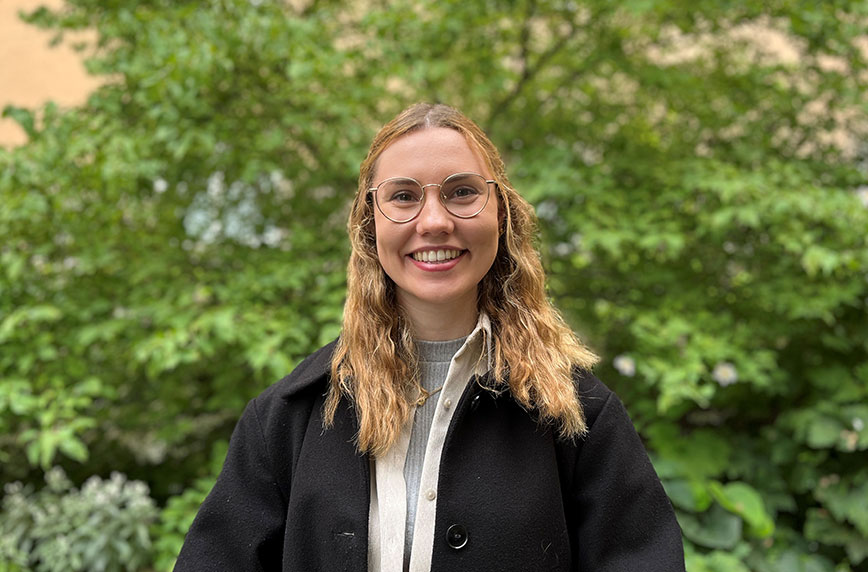Laura
Laura, who is 23 years old, comes from Germany and is currently pursuing her master’s degree in Mathematics in Stockholm. She completed her Bachelor of Science in Mathematics and Philosophy at LMU, Munich. When she is not immersed in the realms of abstract proofs, you can find her hiking, dancing ballet, playing board games, or hosting fun-filled themed parties with her friends.

What are the best aspects of your programme?
I appreciate that we, as mathematics master's students, are students at both KTH and Stockholm University (SU). We have access to all the advantages and networks of both institutions. In concrete terms, this means we have a wide range of courses to choose from, we can study in the facilities of both KTH and SU, and we can join both student unions.
Another benefit of studying in Stockholm is the international and inclusive learning environment. Wherever you go, relevant information will be available in English. As an international student, I don't feel exotic at all; everybody is very welcoming, and many professors are not Swedish themselves.
Furthermore, I feel close to current mathematical research. This is thanks to the monthly talks organised by the Stockholm Masters' in Mathematics Seminar, as well as the opportunity to attend the Göran Gustafsson lecture series. One of my many highlights so far has been a guided tour through the Mittag-Leffler Institute, a prestigious mathematical research institute run by the Royal Swedish Academy of Sciences. With its rich history, this place encapsulated the long-lasting tradition of mathematical research in Stockholm and, to me, was an inspiring place to visit.
What are some of your favourite courses so far?
One course I enjoyed very much was Game Theory (SF2972), where we learned about rational decision-making and the fascinating dynamics that unfold when individuals or entities engage in strategic behaviour.
The course Topology (MM7041) was a lot of fun as well. There, we examined concepts like compactness, connectedness, and the powerful tools of topological invariants, which provided me with a solid foundation for understanding the underlying structure of geometric spaces.
Lastly, I'd like to mention my Swedish courses (LS1502 & LS1512). They were highly interactive, allowing us to practice the language directly in the classroom. It feels great to understand the language spoken around you, even though everyone here speaks perfect English.
How do studies at KTH differ from your previous studies?
A big difference to me was the flat hierarchies in Sweden. I was used to addressing professors formally and them keeping their distance from students. Here, we address professors by their first names, and talking to them or asking questions is completely normal. I found most lecturers very supportive of their students' ambitions. Additionally, a strong focus lies on collaboration between the students in contrast to a focus on individual work, which I was used to. I also like that everything is very digital, e.g., we hand in assignments online and not on paper, as was the case during my bachelor's.
How is student life in Stockholm?
Stockholm offers a vibrant student life. The student unions provide a variety of social activities, ranging from wine tastings to board game evenings and kayaking trips – there is something for everybody. I'd recommend every incoming student to join one of the unions and actively engage with them. It's a great way to get to know your fellow students and participate in fun activities on a low budget. For example, consider participating in the international reception by THS MAIN, and you will have an exciting first few weeks filled with many events.
Apart from that, many students live close to one another, e.g., in the student city Lappis or in one of the KTH Accommodation buildings. Usually, students there gather together and organise events too.
How would you describe your time at KTH so far?
Since I came here, I have had an unforgettable time enjoying breathtaking views of Stockholm, delicious Swedish fika, amazing people, and, first and foremost, lots of fascinating mathematics.
One aspect that brings me joy on a daily basis is that the Stockholm campuses are beautiful. The typical red KTH brick buildings look stunning; the math tower, in particular, reminds me of Hogwarts from Harry Potter. Campus Albano is very modern, with height-adjustable tables and technological equipment like TVs in every single group room. Both in KTH and SU, a lot of artwork is exhibited, ranging from statues of ancient scientists to modern light installations. Nearly every day, I discover something new. In KTH, there are even ceiling paintings. Also, being a night owl, I like to study in the evening and with my KTH card, I can access the buildings 24/7 and study there whenever I want.
What do you want to do after graduating?
After graduating, I aim to work in management consulting. With analytical and problem-solving abilities honed through my studies in mathematics, I hope to contribute to strategic decision-making.
What would you like to say to students thinking of choosing KTH for master's’s studies?
Beware of the cold and dark Swedish winters. But otherwise, grab your winter jacket and come to Stockholm. I'm sure you will like it here! In case you have any questions, feel free to contact me.
